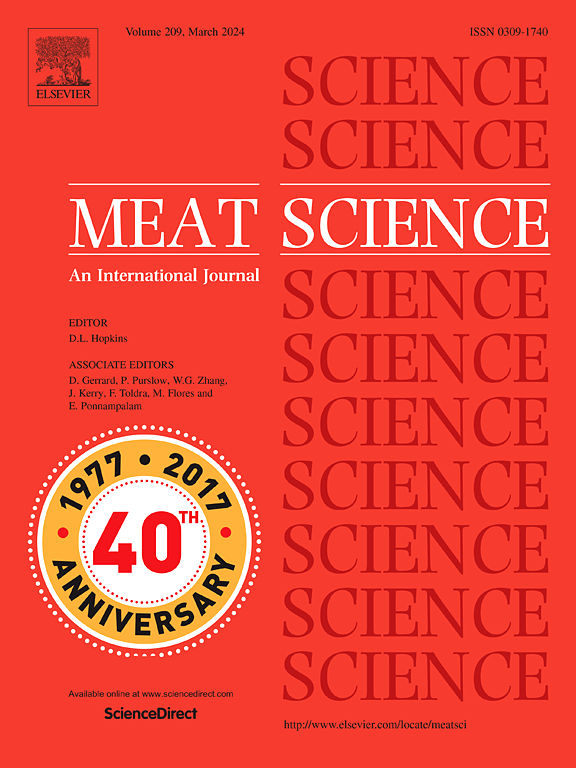用三聚磷酸钠和真空烹调处理的冷冻水牛腰肉的理化、微观结构和感官特性
IF 6.1
1区 农林科学
Q1 Agricultural and Biological Sciences
引用次数: 0
摘要
本研究研究了不同浓度的三聚磷酸钠(STPP)对冷冻水牛腰肉的理化性质(pH值、蒸煮损失、保水能力、颜色性质和剪切力)、脂质氧化(硫代巴比托酸反应物质,TBARS)、二级蛋白质结构(傅里叶变换红外,FTIR)、微观结构(扫描电子显微镜,SEM)和感官属性(描述性分析)的影响。从印度进口的商业水牛腰肉(黑金)作为样本(n = 15)。将它们切成2厘米厚的牛排,注入0%、0.15%和0.3%的STPP,真空密封,在4°C下滚煮1小时。随后,在60°C下真空烹调6小时。结果表明,STPP显著提高了pH值,减少了蒸煮损失,增强了保水能力。较高的STPP浓度增加了亮度和红度,同时降低了剪切力值。0% STPP组的TBARS在第7天达到2 mg MDA/kg,而0.15%和0.3% STPP组的水牛腰肉分别在第21天和第28天达到这一水平。FTIR显示,添加0.15%和0.3% STPP的牛腰肉的二级蛋白结构模式相似,而未添加STPP的牛腰肉的二级蛋白结构模式不规则。扫描电镜分析显示,在0.3%的STPP样品多孔的肌肉纤维和更薄的肌膜,表明更大的压痛。感官评价证实,当STPP浓度为0.3%时,其视觉吸引力、多汁性和香气均有改善。本文章由计算机程序翻译,如有差异,请以英文原文为准。
Physicochemical, microstructural, and sensory attributes of frozen Buffalo loins treated with sodium tripolyphosphate and sous-vide cooking
This study investigates the effects of sous-vide cooking with varying concentrations of sodium tripolyphosphate (STPP) on the physicochemical properties (pH, cooking loss, water-holding capacity, colour properties, and shear force), lipid oxidation (thiobarbituric acid reactive substances, TBARS), secondary protein structures (Fourier transform infrared, FTIR), microstructure (scanning electron microscope, SEM), and sensory attributes (descriptive analysis) of frozen buffalo loins. Commercial buffalo loins (Black Gold) imported from India were used as samples (n = 15). They were sliced into steaks of 2 cm thickness, injected with 0 %, 0.15 %, and 0.3 % STPP, vacuum-sealed, and tumbled at 4 °C for 1 h. Subsequently, they were cooked sous-vide at 60 °C for 6 h. Results indicated that STPP significantly increased pH, reduced cooking loss, and enhanced water-holding capacity. Higher STPP concentrations increased lightness and redness while lowering shear force values. TBARS reached 2 mg MDA/kg in the 0 % STPP group by day 7, while buffalo loins with 0.15 % and 0.3 % STPP reached this level by days 21 and 28, respectively. FTIR showed similar secondary protein structure patterns in buffalo loins with 0.15 % and 0.3 % STPP, while the untreated sample had irregular patterns. SEM analysis revealed porous muscle fibres and thinner perimysium in the 0.3 % STPP samples, indicating greater tenderness. Sensory evaluation confirmed improvement in visual appeal, juiciness and aroma with 0.3 % STPP concentration.
求助全文
通过发布文献求助,成功后即可免费获取论文全文。
去求助
来源期刊

Meat Science
工程技术-食品科技
CiteScore
12.60
自引率
9.90%
发文量
282
审稿时长
60 days
期刊介绍:
The aim of Meat Science is to serve as a suitable platform for the dissemination of interdisciplinary and international knowledge on all factors influencing the properties of meat. While the journal primarily focuses on the flesh of mammals, contributions related to poultry will be considered if they enhance the overall understanding of the relationship between muscle nature and meat quality post mortem. Additionally, papers on large birds (e.g., emus, ostriches) as well as wild-captured mammals and crocodiles will be welcomed.
 求助内容:
求助内容: 应助结果提醒方式:
应助结果提醒方式:


